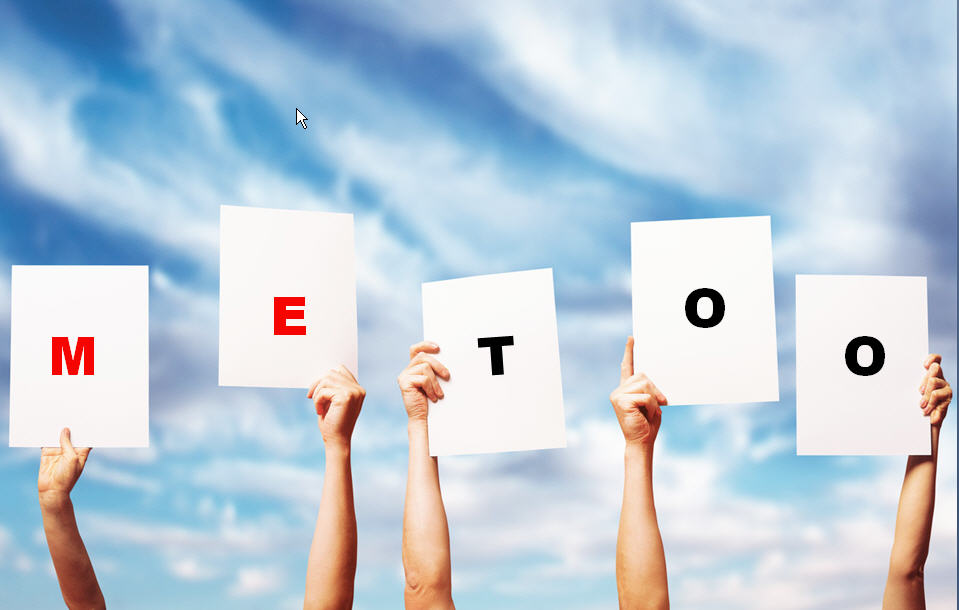In the last 3 weeks, since multiple allegations of sexual assault by Harvey Weinstein became public, a slogan has appeared that has taken the internet by storm.
Perhaps, however, the analogy of a tempest diminishes the gravity of the slogan’s message.
You see, a storm is not merely overwhelming, it is fearsome, often beautiful… and sometimes, even captivating.
This slogan, however, although overwhelming in its volume, has been anything but beautiful, and is far from captivating.
#metoo
As we scroll through our social media feeds, it springs up where we least expect it. Immediately, and before we have time to process it completely, our subconscious minds remind us that we know what it means… that we are in on a secret. And then our conscious minds remind us of the ugly and sordid nature of the secret… the pain that “me too” represents.
We realize that there is a club, a secret society, if you will, of women who never wanted nor asked to become members of this particular sisterhood. It is estimated that more than 300,000 women ages 12 and older will be the victims of sexual assault each year. Statistics further state that at least 1 in 3 women, ages 18-34, will fall prey to sexual harassment in the work place. This number excludes women under the age of 18 and over the age of 34; further it excludes non-employment settings in which sexual harassment can and does occur.
The #metoo movement crept up rather slowly and took a quiet but significant stronghold on the internet. This one brief statement, void of any verb or action word, and with a humility conveyed by the brevity of the words and its lowercase letters, says more about the experiences that those who post it have had, than any essay or narrative ever could.
“me too” quietly documents violence against and the victimization of women, as well as the silence and shame in which they have suffered.
And “me too” made it personal. Because, even if it didn’t happen to you, you probably found that you knew many women who broke their silence and posted those words. They gave you a glimpse into a hell that they may have endured, and bared a wounded part of their souls. These women are your neighbors, your co-workers, your classmates, your church sisters and fellow PTA members, your cousins, your aunts and some of your closest friends.
… all in an internet act of solidarity, which had more impact than a demographic study ever could.
“me too” documents that sexual assault and harassment are pervasive… ubiquitous in our culture. And, just imagine, that for all of the posts with “me too”, still, not everyone is represented.
And just as the “me too” posts began to emerge, so did the revelations of an ever-growing number of famous and powerful men who’d violated women that they should have honored. Names like Kevin Spacey, Dustin Hoffman, Jeremy Piven, Brett Ratner have started to litter the pages of the internet and tabloids. Prior to this, was the wave of scandal of famous tv anchors who’d predated upon their female co-workers. Roger Ailes, Bill O-Reilly, Eric Bolling.
George Bush.
And as the names have emerged, each day, so has the number of women coming forward with allegations of sexual assault.
Wow. We’d thought that it was only Bill Cosby.
Remember that?
And to this day, his accusers are still being challenged about the validity of their accounts. Many of the naysayers have been other women.
But now, after Weinstein, it doesn’t seem so farfetched, does it?
After my own “me too” post, a friend sent me a message that I found quite sobering. She reminded me of an instance years ago, in which we’d been at a graduation party and a mutual friend’s boyfriend made numerous unwanted physical advances towards me. At the time, I’d not said anything to our friend, because I was concerned about how hurt she might be. I chose to write off his attempts at gropes and grinds to be the actions of a jackass, whom I was fairly certain I’d never have to see again.
And I’d forgotten it until my friend brought it up last week.
Prior to that, I hadn’t thought much of it; other than to think that this is one of the things that women must tolerate from disrespectful men. I chose not to think of it as harassment or as an invasion of my personal space and boundaries, but to see it as a nuisance.
But Sharon didn’t. She wrote,
“I think we are so used to it that we don’t even think about it… the remarks and looks… we just blow it off and keep moving.”
And she was correct. How sad. She was correct.
In my stream of consciousness, I had decided that these types of invasions did not rise to the level of harassment or assault because my clothing had not been torn off, and there was no penetration or overt violence directed against me. I had decided that these seemingly “minor” acts were excusable, and I did the unforgivable by excusing them.
But her comment made me reckon with that.
As per the US Department of Justice, the definition of sexual assault is:
“… any type of sexual contact or behavior that occurs without the explicit consent of the recipient. Falling under the definition of sexual assault are sexual activities as forced sexual intercourse, forcible sodomy, child molestation, incest, fondling, and attempted rape.”
Oxford Dictionary has defined it as:
“Harassment (typically of a woman) in a workplace, or other professional or social situation, involving the making of unwanted sexual advances or obscene remarks.”
Unfortunately, the legal definition of sexual harassment refers only to the work place. The most cited definition derives from the EEOC’s guidelines regarding sexual harassment and describes it as:
“Unwelcome sexual advances, requests for sexual favors, and other verbal or physical conduct of a sexual nature constitute sexual harassment when
1 submission to such conduct is made either explicitly or implicitly a term or condition of an individual’s employment,
2 submission to or rejection of such conduct by an individual is used as the basis for employment decisions affecting such individuals, or
3 such conduct has the purpose or effect of unreasonably interfering with an individual’s work performance or creating an intimidating, hostile, or offensive working environment.”
In doing this, under Title VII of the Civil Rights Act of 1964, an employee may sue an employer for acts of sexual harassment that occur at work.
And it is wonderful that these protections are provided for the workplace.
But, what did we forget?
More importantly, who did we forget?
The children. We forgot about them.
Typically, we teach children to protect themselves against strangers who might molest, and otherwise harm them, but we have failed to give them constructive strategies for addressing classmates and peers who may be harassing them sexually.
“Stranger Danger” is wonderful for people who they may not know, but doesn’t work very well against schoolmates and neighbors.
When I consider my willingness to excuse men for inappropriate advances over the years; when I consider that many of my friends and female associates have done the same, I have to ask “why?”
What message did we get that it was acceptable to minimize these interactions and that we need not make mention of them or demand more respectful treatment?
I would posit that we received these messages as children. The lesson that boys are “…just playing…” and that we should neither tattle nor be too sensitive, is taught early and reinforced frequently. It started for many of us in grade school, and by the time we were adults, we’d been conditioned to ignore certain behaviors.
There have been many studies done regarding sexual harassment among middle school students. While different populations have been studied in different states and by different groups of researchers, the statistics are all shockingly similar.
In the October 2017 issue of Psychology Today, Dr. Christia Brown writes,
“Sexual harassment, which includes unwelcome sexual advances, requests for sexual favors, and other unwanted verbal, nonverbal, or physical sexual conduct, begins for girls in late elementary school. By the sixth grade, more than one-third of girls have been sexually harassed by a boy, and by middle school, almost all students (95 percent) have witnessed sexual harassment happen at school… by the end of high school, 90 percent of girls have experienced sexual harassment at least once, with 62 percent being called a nasty or demeaning name, 51 percent receiving unwanted physical contact at school, and 28 percent being teased, threatened, or bullied by a boy. For the girls who attend college, their risk of being sexually assaulted increases, and 1 in 4 will be sexually assaulted while in school, usually by an acquaintance.”
In 2014, US News and World Report documented the following:
“Researchers from the University of Illinois at Urbana-Champaign surveyed nearly 1,400 students from four Midwestern middle schools on whether they had experienced unwanted sexual harassment. Overall, 27 percent of girls and 25 percent of boys reported they had experienced verbal or physical sexual harassment or violence.
The most commonly reported form of harassment was unwanted physical touching, which was reported by 21.6 percent of the students who said they had experienced harassment. Rumor-spreading, verbal sexual commentary and homophobic name-calling were the next most frequently reported at 18.9 percent, 18.2 percent and 17.9 percent, respectively.”
And the New York Times chronicled the issue back in 2008:
“To study the issue, Dr. Fineran and coauthor James Gruber from the University of Michigan in Dearborn surveyed 522 children between the ages of 11 and 18 about their experiences with bullying and sexual harassment at school. Overall, 35 percent of kids reported they had been victims of some form of sexual harassment.”
In fairness to our public schools, there has been one area in which legal protection is afforded students, and that is through Title IX of the Education Amendment of 1972.
“Title IX… prohibits discrimination on the basis of sex in education programs and activities receiving Federal financial assistance. Sexual harassment of students can be a form of discrimination prohibited by Title IX. The Office for Civil Rights has long recognized that sexual harassment of students engaged in by school employees, other students, or third parties is covered by Title IX.”
In the document, “Sexual Harassment Guidance from the Department of Education’s Office of Civil Rights”, it is written,
“…that sexual harassment can interfere with a student’s academic performance and emotional and physical well-being, and that preventing and remedying sexual harassment in schools is essential to ensure nondiscriminatory, safe environments in which students can learn.”
The OCR, however, has rather loose definitions regarding what constitutes sexual harassment, and that the designation of such is dependent upon multiple factors including age and whether or not the events were, “… sufficiently severe, persistent, or pervasive that [they] adversely affect a student’s education or create a hostile or abusive educational environment. For a one-time incident to rise to the level of harassment, it must be severe.”
It goes on to state that, “… Even if a school determines that a student’s conduct is sexual harassment, the Guidance explicitly states that Title IX permits the use of a general student disciplinary procedure.”
Unfortunately, the protection that Title IX offers becomes dilute when the above mentioned stipulations are applied. It can inadvertently foster an environment in which many episodes of would-be harassment can occur and become commonplace because they do not quite meet the criteria for harassment. However, their psychological and emotional impact upon the victim are no less harmful.
The next limitation of Title IX is that it only governs institutions that receive federal funding. This means that any private institutions of learning, and therefore, their students, are excluded from this protection. The victims are excluded and the perpetrators are exempt.
In many school districts, inappropriate sexual gestures, name calling, groping and ogling will be lumped into the catchall category of bullying, and then treated as such.
The New York Times goes on to explain,
“Schools often focus only on general bullying problems, but Drs. Fineran and Gruber argue that sexual harassment is a distinct problem that should be addressed separately, in part because laws, particularly the education law known as Title IX, already exists to protect students from sexual discrimination and harassment at school.
Title IX protects everybody in school against this kind of behavior, but as soon as you call something ‘bullying,’ then it’s just viewed as ill behavior that one student does to another student,” Dr. Fineran said. “Sexual harassment is really an environmental problem for the school. The school needs to do something about stopping sexual harassment because they’re legally bound to.”
And we all know how effectively most school districts handle bullying, don’t we?
So our children don’t stand a chance… that is, unless we change how we view and address sexual harassment in elementary through high school.
And why wouldn’t we do all that we can to teach and redirect students who find it funny to grab, caress or fondle a classmate; or to hurl sexually explicit rhetoric towards others?
By not being more clear about what sexual harassment and assault look like, and by failing to implement effective teaching, correction and disciplinary measures on the subject, we inadvertently subjugate victims of harassment.
We also empower and bolster their attackers. And we run the risk of raising another generation of Weinsteins and Cosbys. In the process, we demoralize the girls who will one day have to defend themselves against such predators.
And what is the impact of this?
According to Dr. Brown,
“Like the actresses who recounted their fear and anxiety after their experiences, adolescent girls report that sexual harassment leads to trouble sleeping, difficulty studying, embarrassment, anxiety, fear, depression, substance abuse, and suicidal thoughts. One-third of girls who experience sexual harassment report not wanting to go to school. Absenteeism spikes. It is not surprising that girls want to avoid the place where they are made to feel objectified, self-conscious, and vulnerable. Of course, this is the same place where they are also supposed to learn algebra and chemistry.”
In addition to it being insufficient, Title IX has recently come under significant attack.
Under the leadership of Betsy Devos, Title IX protections were stripped bare. Schools are no longer expected to offer students protection against sexual assault and harassment.
Now, victims within the public school system are left to be re-victimized by their oppressors and then by the school system that they attend. The victims are further violated while their oppressors are vindicated.
So where do we start? And what do we do? How does effective prevention look?
Thus far, it appears that the status quo does little to effectively prevent sexual harassment or assault.
Part of the problem is that prevention is defined within the realm of punitive measures.
Consider that, by definition, the need to impose a penalty suggests that prevention was ineffective in the first place. In order to be penalized, an offense had to have occurred.
And our country’s penal system proves time and again that punitive strategies are lacking in efficacy.
So, why not try to truly pre-empt such ills?
Pre-emption would require a change in philosophy, and one that begins in the home as opposed to within the school. It should begin within the family and extend out to the greater community.
According to a recent article in the Washington Post,
“Youth are exposed daily to the pervasive and nearly invisible ways that our society accepts and even condones sexually abusive behavior.”
“Prevention needs to begin in early childhood and continue for life. Teaching skills to prevent violence starts with learning empathy for others, communication skills and problem solving. It involves promoting healthy sexual behavior through sex education focused on respect for self and others, communication and consent. Programs that empower youth to make positive changes in their communities show promise for preventing sexual violence.
School boards, employers and politicians have the power to strengthen and consistently apply policies to keep schools, workplaces and communities safe by holding abusers accountable for their actions. Leaders, and all bystanders, can refuse to hide or tolerate abusive behavior. Last, we can support services for both male and female victims that reduce the harm of these traumatic experiences.”
One preventive strategy that has been met with acclaim is that of teaching our very young children, specifically toddlers and preschoolers, to become aware of and honor their personal boundaries; to be assertive when they do not want to be hugged or kissed by an adult with whom they may not feel comfortable.
It may seem like an innocuous gesture, but when we encourage them to succumb to such pressure, we inadvertently send the message that we do not respect their physical bodies and feelings of safety, and that they need not, either. If this message is delivered to them in small doses, but for long periods of time, then it is no wonder that they become conditioned to disrespect the boundaries of others.
They have learned that personal safety is secondary to keeping the peace or “going along to get along”. They have learned that it is acceptable to disrespect others and to be disrespected. Healthy boundaries can neither established nor respected when this is the paradigm from which a person operates.
Unless, as individual families, and then as a society at-large, we shift this paradigm, we will unwittingly continue to raise new Harvey Weinsteins and Bill Cosbys, and we will usher in a new generation of women who will continue to say, “me too”.










